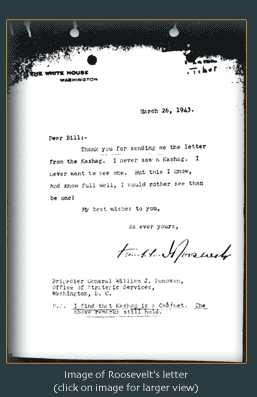|
|
 |






Initial American involvement in Tibet
Until the Chinese invasion of 1950, America’s involvement in Tibet had been negligible. During the Second World War, Washington sent two OSS officers to Lhasa to explore the possibility of using Tibet as an overland route for sending supplies to its embattled Kuomintang ally, Chiang Kai Shek. Led by Captain Ilya Tolstoy, the grandson of the great Russian novelist, the mission arrived in Lhasa in December of 1942, bearing gifts from President Roosevelt for the young Dalai Lama. The two men were warmly received and spent more than three months in the Tibetan capital although the main purpose of their mission remained unfulfilled. Later, when the OSS chief, William Donovan, forwarded the President a letter of appreciation from the Tibetan Cabinet (known as the Kashag), he responded thus:

Dear Bill –
Thank you for sending me the letter from the Kashag.
I never saw a Kashag.
I never want to see one.
But this I know, and know full well,
I would rather see than be one.
P.S. I find that Kashag is a Cabinet. The above remarks still hold.
F.D.R.
The Communist victory in China in 1949 and the subsequent military invasion of Tibet drastically changed America’s hitherto relative disinterest in the country. In December 1950, a few months after the People’s Liberation Army overran the meager Tibetan defenses at Chamdo in eastern Tibet, the State Department sent an aide-mémoire to the British Embassy in Washington, which stated:
The United States, which was one of the early supporters of the principle of self-determination of peoples, believes that the Tibetan people has the same inherent right as any other to have the determining voice in its political destiny. It is believed further that, should developments warrant, consideration could be given to recognition of Tibet as an independent state.
Seeing that neither India nor Britain – the two countries with historical connections to Tibet – were particularly keen to challenge the Chinese invasion, the United States Government went ahead with its own efforts to intervene. The young Dalai Lama had fled to Southern Tibet where he set up temporary headquarters at the village of Dromo. In Beijing, his emissaries had been forced to sign the 17-Point Agreement under the terms of which Tibet lost its sovereignty. The United States Government, through its embassy in New Delhi, made several attempts through unofficial channels to convince the Dalai Lama to repudiate the agreement and go into exile. In return, America promised to make a public announcement supporting the position of the Dalai Lama as head of an autonomous Tibet. Furthermore, they would fund his stay while in exile, support Tibet’s appeals to the United Nations and back any resistance movement that might emerge within the country. However, all these efforts came to nothing when the Dalai Lama – strongly influenced by his religious advisors and members of his Cabinet – made the decision to return to Lhasa. Another five years would pass before the United States Government, this time through the offices of the CIA, would once again became actively involved in Tibet’s affairs.
(For a more detailed study of this period see Tsering Shakya’s, The Dragon in the Land of Snows and Ken Knaus’ Orphans of the Cold War.)

Return To Timeline | Return To Top
|



